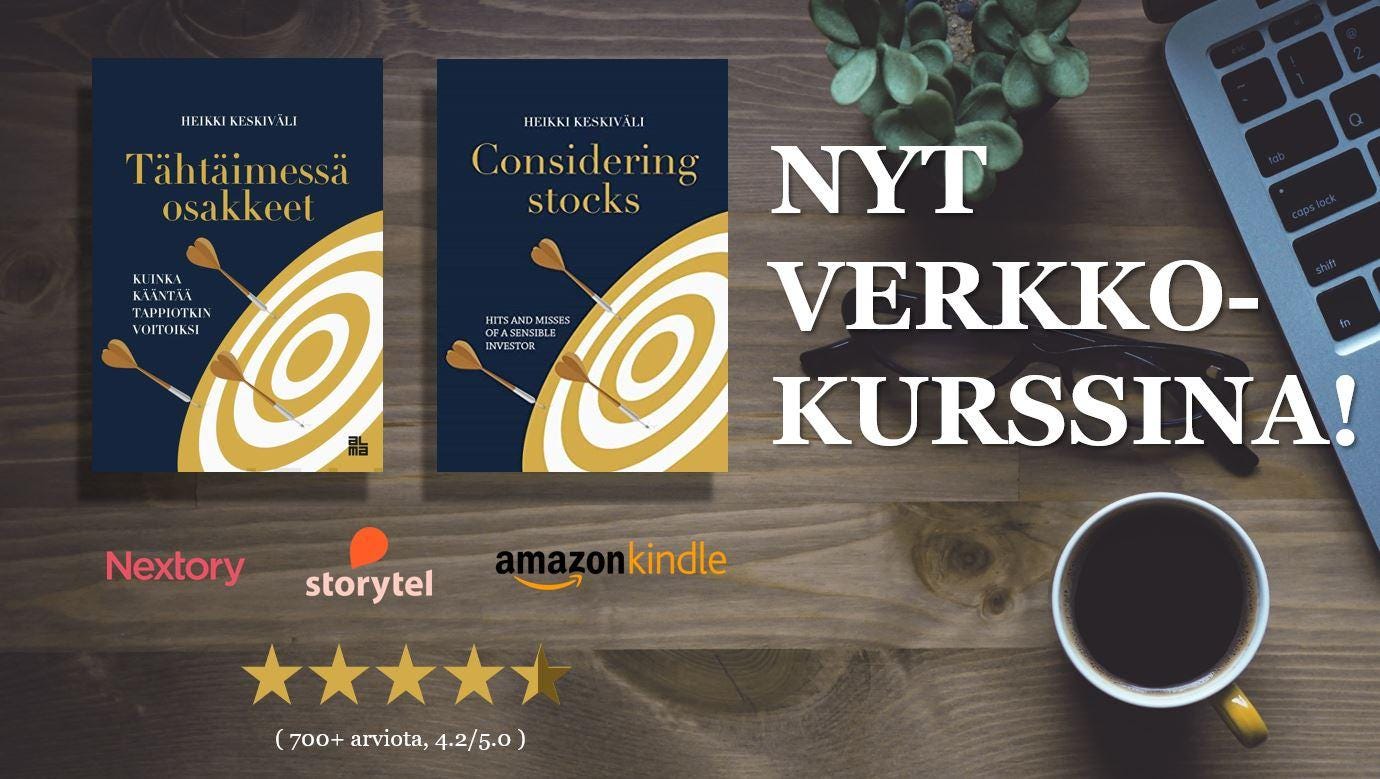Heikki Keskiväli's portfolio
What’s in the portfolio, and why have I changed my approach to transparency regarding investments over the years?
Almost every time a journalist calls about an investment article, it includes a question about my latest buys or sells. If a new acquaintance hears that I'm a passionate stock picker, one of the first questions is often for a tip on the next stock rocket — as if I always had one ready to offer. On top of that, the phrase “Heikki Keskiväli portfolio” is, according to my website analytics, one of the most popular web searches related to me.
Clearly, there's significant interest in the topic, so let's weigh in on discussing stock picks. At the same time, let's ensure that those searching for information online will find the right place. We'll break down the topic into its pros and cons.
PRO: STRUCTURING THOUGHTS
Talking about companies helps organize thoughts and justifications. Writing is an excellent way to clarify sometimes meandering thoughts and forces one to simplify complexities. The writing process often brutally exposes gaps in one’s reasoning, thereby improving one's approach.
PRO: STRESS-TESTING INVESTMENT THESIS
When discussing and writing about companies, you end up putting your investment thesis under the scrutiny of others. Others often have perspectives or data points that you hadn’t considered, or hadn’t even come across.
Sharing ideas is, in its own way, an invitation for others to challenge the weaknesses in your reasoning or validate the arguments behind your thesis. Both are valuable in the investment process and its development—though recognizing your own blind spots is ultimately the more valuable of the two for me personally.
CON: FEEDING THE EGO
Of course, it does feed the ego when a publicly shared idea turns out to be a big win. But if you've written about an idea in which you have strong conviction (read: significant portfolio weight), then simply being proven right should be reward enough—there's no need to shout it from the rooftops. In general, anything related to ego can stealthily lead you down the wrong path and easily seep into your investment process, lowering its quality.
It's about choosing between external and internal motivations and deciding which you want to prioritize. As Warren Buffett puts it: "Would you rather be the world's greatest lover, but have everyone think you're the world's worst lover? Or would you rather be the world's worst lover but have everyone think you're the world's greatest lover?"
CON: IMPACT ON THE INVESTMENT PROCESS
Most of us, myself included, prefer to be right. After all, who would willingly want to be wrong?
If you’ve shared a well-reasoned idea that ends up failing, it forces you to admit you were wrong. In practice, there’s a big difference between quietly acknowledging this to yourself and doing so publicly. Subconsciously, this can easily lead to “justifying” things in a more favorable light—in other words, actively seeking reasons that still support the idea while ignoring the negative evidence.
This phenomenon is known as confirmation bias. At its worst, you may end up holding on to a deteriorating idea for far too long, leaving your money tied up instead of reallocating it to better opportunities. A poor outcome, and for an entirely avoidable reason.
CON: ENGAGEMENT FARMING
Direct stock buy/sell “tips” are typically the hottest currency, which is why financial media is filled with clickbait headlines of that sort. Let’s be honest—many likely started reading this article in hopes of finding new stock ideas. Engagement farming in action.
Often, these so-called “hot tips” drastically shortcut an investor’s decision-making process, rushing straight to the conclusion without much context. Many journalists are more interested in the company’s name than the reasons behind selecting it. In my view, the choice itself is often the least valuable part; the rationale leading to the selection, its originality, and how it can be applied to other investments are far more interesting (and scalable).
Process eats outcome for breakfast. Focusing on the scoreboard instead of the game itself will quickly leave you behind.
CON: BLINDLY FOLLOWING
Despite all this, I wrote about one of my portfolio holdings a few weeks ago. For the very reasons mentioned above, I made it clear in the text:
"Please note that I may change my mind at a moment’s notice without any separate update or duty to do so to anyone - do your own research"
Yet, on the Inderes discussion forum, the impact of the article was closely monitored, and it led to people blindly copying the move; the number of shareholders on Nordnet more than doubled.
Even if the intention is to discuss ideas, many will blindly follow along by buying shares. This is particularly problematic because buying is just one of the three crucial actions to manage: buying, holding, and selling.
Patiently holding onto stocks is, in reality, an emotional rollercoaster. Conditions can quickly change within the company, in its surrounding environment, or elsewhere in the portfolio, prompting a sale. If things don’t go as planned with the company, you’ll soon be faced with a flood of questions asking why. If those questions go unanswered, it may come off as arrogant: “The stock moved, why did this happen? Why aren’t you responding?”
While the writer may simply be reflecting on the current state of the company and their perspective on it, sharing these insights can create an expectation among readers to receive updates in the future. If your investment thesis changes, many expect to be informed. If shares are bought or sold, they want to know about it too. The pressure mounts to always be clear on what to do next, effectively outsourcing decision-making responsibility.
In reality, those writing about companies have no obligation to provide updates, and every investor is always responsible for their own decisions. Issues rarely arise if your thesis plays out well. However, if problems accumulate and promised returns turn into a mirage in the distance, people are quick to point fingers at others rather than looking in the mirror.
Deliberately misleading people for personal gain (i.e., “pump and dump” schemes) is, of course, the work of scoundrels—that goes without saying.
So far, we have two pros and four cons for transparently discussing stock picks and the contents of a portfolio. From my perspective, this makes the whole experience net negative, while the investment process itself is a far more meaningful topic. However, people are different, and for someone else, transparency may give more than it takes. For one, I myself benefit from reading others' insights.
Nevertheless, let’s go ahead and open up the composition of my portfolio a bit.
MY PORTFOLIO AT THE MOMENT
To wrap things up, let's summarize previously disclosed holdings (Red Violet, Rusta, and Burberry), as well as the highly concentrated nature of the portfolio.
Below, you’ll find all the positions in the portfolio along with their respective weights. There are a total of 11 investments spread across six countries, with the top five holdings making up 82% of the entire portfolio. As of the time of writing, North America accounts for 43% and Europe for 57% of the portfolio, with the Nordics representing 29%. Over the past year, I’ve gradually shifted focus from America toward Europe.
At this time, there’s no intention to dive deeper into the individual holdings; the reasons for this should already be quite clear at this point. However, should particularly interesting cases arise, I will certainly share my thought process, even if the company in question is not part of the portfolio!
Next time you meet a stock picker, don’t ask what they’ve recently bought. Instead, ask what their process was for choosing that company.
If you enjoyed this or learned something new, you may also want to follow me on X, formerly Twitter. My Finnish followers may also want to check out “Tähtäimessä osakkeet” book and online course or more about me on my website www.heikkikeskivali.com
Thank you for reading!








